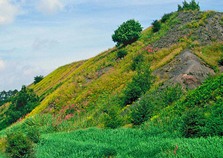

Biodiversity
Action
Plan

Wild strawberry on limestone rubble
at Wogden Foot Local Wildlife Site, former railway sidings.
Open Mosaic Habitat on Previously Developed Land.
Brownfield sites but ‘left to nature’ can support a surprising amount of biodiversity on the disturbed poor soils and aggregates there.
Barnsley’s historic legacy of industrial sites, colliery pitstacks, quarries, and railway tracks, has left a landscape dotted with such places.
Plants that can grow and survive there, colonise previously developed and disturbed land and can form a patchwork of plant communities and bare ground. This is referred to as ‘open mosaic’ habitat.
Open Mosaic on Previously Developed Land is a national priority habitat found in Barnsley where soils have been modified and one or more early successional communities have become established in a mosaic with bare substrate.
Spectacular assemblages of native and other plants occur on some sites due to the soils being disturbed and ‘alien’ materials introduced.
‘Hanging Gardens of Grimethorpe’
on former colliery pit stack.

Priority habitat details
Open mosaic habitat on previously developed land is a priority because of the special species and communities it supports, particularly plants and invertebrates.
It is a UKBAP priority habitat and S41 habitat of principal importance for conservation
UKHab surveys report it as u3A: open mosaic habitat on previously developed land.
Phase 1 habitat surveys classify this type of habitat as: Quarry, Spoil, Mine, Ephemeral/short perennial, Bare Ground. Grass-land or heath may be present.
Criteria for open mosaic habitat on previously developed land:
- at least 0.25 ha in size.
- soils disturbed, removed or severely modified by previous use(s) of the site.
- some unvegetated loose bare soils or substrate
- early successional plant communities* (one or more)
- spatial variation/mosaic of
- one or more early successional communities
- bare substrate
*Examples of early successional communities: mosses, lichens, annuals, ruderals, open or flower-rich grassland, heathland.
Other specialised habitats may be found where there is industrial spoil or limestone ballast affecting the soil: the types of vegetation found may be very different to elsewhere in Barnsley. These are included in the Local Priority Habitat.
Previously Developed Land
These unusual sites in turn support special assemblages of invertebrates, and amphibians, reptiles, mammals and birds may also be present.
For more information on Open Mosaic Habitat on Previously Developed Land, follow these links:
Quite specialised habitats may be found where industrial spoil or limestone ballast affects the soils: the types of vegetation found may be very different to those found elsewhere in Barnsley.
Indeed plants that normally grow in coastal areas have been found locally on the former Grimethorpe Colliery pitstack.

Cudworth Common vegetation
on former colliery site